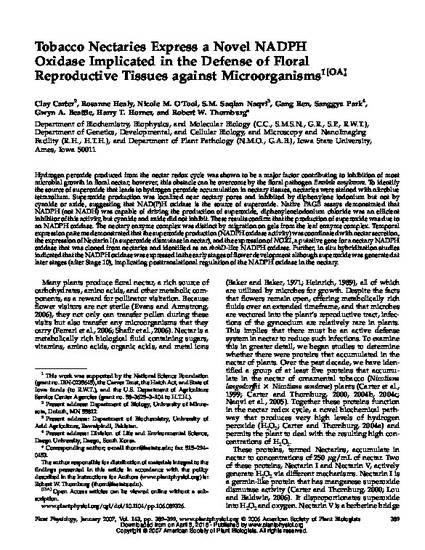
Hydrogen peroxide produced from the nectar redox cycle was shown to be a major factor contributing to inhibition of most microbial growth in floral nectar; however, this obstacle can be overcome by the floral pathogen Erwinia amylovora. To identify the source of superoxide that leads to hydrogen peroxide accumulation in nectary tissues, nectaries were stained with nitroblue tetrazolium. Superoxide production was localized near nectary pores and inhibited by diphenylene iodonium but not by cyanide or azide, suggesting that NAD(P)H oxidase is the source of superoxide. Native PAGE assays demonstrated that NADPH (not NADH) was capable of driving the production of superoxide, diphenyleneiodonium chloride was an efficient inhibitor of this activity, but cyanide and azide did not inhibit. These results confirm that the production of superoxide was due to an NADPH oxidase. The nectary enzyme complex was distinct by migration on gels from the leaf enzyme complex. Temporal expression patterns demonstrated that the superoxide production (NADPH oxidase activity) was coordinated with nectar secretion, the expression of Nectarin I (a superoxide dismutase in nectar), and the expression of NOX1, a putative gene for a nectary NADPH oxidase that was cloned from nectaries and identified as an rbohD-like NADPH oxidase. Further, in situ hybridization studies indicated that the NADPH oxidase was expressed in the early stages of flower development although superoxide was generated at later stages (after Stage 10), implicating posttranslational regulation of the NADPH oxidase in the nectary.
Available at: http://works.bepress.com/gwyn-beattie/19/

This article is published as Carter, Clay, Rosanne Healy, M. O. Nicole, SM Saqlan Naqvi, Gang Ren, Sanggyu Park, Gwyn A. Beattie, Harry T. Horner, and Robert W. Thornburg. "Tobacco nectaries express a novel NADPH oxidase implicated in the defense of floral reproductive tissues against microorganisms." Plant Physiology 143, no. 1 (2007): 389-399. Copyright American Society of Plant Biologists. Posted with permission.